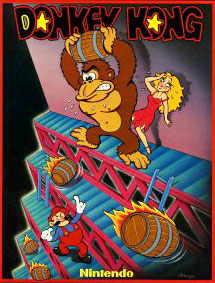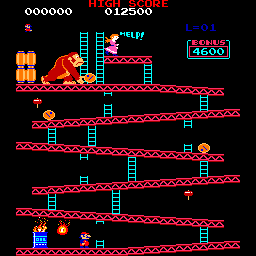 Frank Krmel, of Atlanta, Georgia and Shigeru Miyamoto of Kyoto, Japan are unlikely to find themselves mentioned together in any sentence other than this one. Miyamoto spent his childhood exploring the lakes and caves with which the land around his family home was amply blessed, endlessly drawing and sketching local wildlife. Krmel spent his childhood hunting catfish in a swamp. Both men, however, chased an ape-themed dream which would elevate them to the top of their respective professions: this dream would manifest itself as Donkey Kong, which is also the fourth track on our Pac Man Fever odyssey. For Miyamoto, Donkey Kong was the beginning of an incredible journey that would see him hailed as ‘the Father of Modern Videogames’ by the New York Times, and ‘the Walt Disney of electronic gaming’ by the Wall Street Journal. He invented the Wii gaming system, and his sheepdog, Pikku, was the inspiration for the Nintendogs franchise. For his part, Krmel drove a monster truck called Donkey Kong into the ninth Monster Jam World Finals in 2007. The truck is designed to look like a big monkey wearing a tie. Two men, one shared destiny: an angry gorllla throwing barrels at an Italian.
Frank Krmel, of Atlanta, Georgia and Shigeru Miyamoto of Kyoto, Japan are unlikely to find themselves mentioned together in any sentence other than this one. Miyamoto spent his childhood exploring the lakes and caves with which the land around his family home was amply blessed, endlessly drawing and sketching local wildlife. Krmel spent his childhood hunting catfish in a swamp. Both men, however, chased an ape-themed dream which would elevate them to the top of their respective professions: this dream would manifest itself as Donkey Kong, which is also the fourth track on our Pac Man Fever odyssey. For Miyamoto, Donkey Kong was the beginning of an incredible journey that would see him hailed as ‘the Father of Modern Videogames’ by the New York Times, and ‘the Walt Disney of electronic gaming’ by the Wall Street Journal. He invented the Wii gaming system, and his sheepdog, Pikku, was the inspiration for the Nintendogs franchise. For his part, Krmel drove a monster truck called Donkey Kong into the ninth Monster Jam World Finals in 2007. The truck is designed to look like a big monkey wearing a tie. Two men, one shared destiny: an angry gorllla throwing barrels at an Italian.
Donkey Kong is the most famous of the platform genre, and the inspiration behind giants such as Sonic the Hedgehog It was not the first platform game – this accolade goes to now-forgotten Space Panic, an early Atari effort – but it was the first to use narrative driven gameplay, with cut scenes and primitive dialogue to move the story forward. And what a story it is, too. It appears that the eponymous Kong is owned by Mario, a rotund plumber who has apparantly witheld Kong’s favourite food for some reason. By way of protest, Kong kidnaps Mario’s girlfriend, Pauline, and takes refuge in a building site, from where he hurls fireballs and the aforementioned barrels at the podgy tradesman as he scrambles to her rescue. There are four levels to the game, known to insiders as Barrels, Factory, Elevator, and Rivets, after each ones’ overriding characteristic. Miyamoto and his team prided themselves that Donkey Kong is a considerably more difficult game to master than its early 80s stablemates, a feature it shares with the nine-button madness of Defender (see Defender blog). The 22nd screen is particularly hard to navigate, as the program contains a bug which kills Mario instantly. For this very good reason, it is called the Kill Screen.
 Mario isn’t called Mario in Donkey Kong, of course. He’s known as Jumpman, becoming Mario for the highly successful Super Mario Bros spin offs. The Jumpman moniker was chosen for its’ similarity to astonishing ‘tomorrow’s technology – today!’ entertainment breakthrough, the Sony Walkman. A Walkman was a device for listening to cassette tapes while staying entirely motionless. Considering that blinking, smiling, or even quietly metabolising carbohydrates would cause a Walkman to cut out, it would have been little use to Jumpman as he dodged fireballs while attempting to run along a series of conveyor belts, as he was required to do on the Factory level. Jumpman was eventually named Mario after Mario Segale, a warehouse manager at Nintendo, as Miyamoto and his cohorts attempted to make the game more palatable for the American market. Interestingly, Donkey Kong was so named as Miyamoto struggled to find something that would translate to ‘stupid monkey’ in English. Nintendo America were not impressed with Donkey Kong, pointing out its complexity, weird name, and general bizarreness. Undeterred, two distributors working for Ninendo, Al Stone and Ron Judy, convinced a bar owner in Seattle to take the game. Such was the demand that the pair would buy up other games cabinets, gut them, and refit them with Donkey Kong motherboards. Working entirely on commission, as Nintendo refused to pay them for what it still saw as a waste of time, they became millionaires in fourteen months.
Mario isn’t called Mario in Donkey Kong, of course. He’s known as Jumpman, becoming Mario for the highly successful Super Mario Bros spin offs. The Jumpman moniker was chosen for its’ similarity to astonishing ‘tomorrow’s technology – today!’ entertainment breakthrough, the Sony Walkman. A Walkman was a device for listening to cassette tapes while staying entirely motionless. Considering that blinking, smiling, or even quietly metabolising carbohydrates would cause a Walkman to cut out, it would have been little use to Jumpman as he dodged fireballs while attempting to run along a series of conveyor belts, as he was required to do on the Factory level. Jumpman was eventually named Mario after Mario Segale, a warehouse manager at Nintendo, as Miyamoto and his cohorts attempted to make the game more palatable for the American market. Interestingly, Donkey Kong was so named as Miyamoto struggled to find something that would translate to ‘stupid monkey’ in English. Nintendo America were not impressed with Donkey Kong, pointing out its complexity, weird name, and general bizarreness. Undeterred, two distributors working for Ninendo, Al Stone and Ron Judy, convinced a bar owner in Seattle to take the game. Such was the demand that the pair would buy up other games cabinets, gut them, and refit them with Donkey Kong motherboards. Working entirely on commission, as Nintendo refused to pay them for what it still saw as a waste of time, they became millionaires in fourteen months.
The lyrics to Do The Donkey Kong are so strange as to effectively be strings of words threaded together at random. Tiptoe through the tulips, we are advised, and duck underneath the pie, because it’s a coconut cream. There are no tulips or pies – or indeed, hearty foodstuffs of any description – in Donkey Kong. There are references to opening the umbrella and answering the phone. Clearly, Do The Donkey Kong is Buckner and Garcia’s I Am The Walrus. This should not in any way detract from the game itself, which is a cast iron bulletproof massive classic.
Next week, we’ll be contemplating track five, which deals with Asteroids. You should ensure that any dancing shoes you may wish to bring along are sufficiently weighted for bogolling in zero gravity.

Comments are closed.